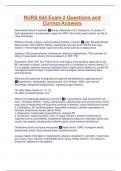NURS 644 Exam 2 Questions and
Correct Answers
Generalized Shock Treatment ✅Airway stabilization (O2, intubation), IV access, IV
fluid replacement, hemodynamic support for MAP >65 mmHg, warm patient, lay flat, &
close monitoring.
What are the lab, imaging, and procedural findings in shock? ✅Labs: Elevated lactate,
base excess, CBC (hgb/hct (falling), electrylytes, glucose level, INR/Ptt and coag
factors in hemorrhagic shock, type and cross, blood cultures in septic shock
Imaging: CXR (pneumothorax, hemothorax, widened mediastinem), TEE (reduced LV
filling in hypovolemic shock), Echo (enlarged LV, RHF, PE)
Procedural: EKG, ART line, Foley (trend urine output, most sensitive response to low
BP, decrease in shock), central venous pressure 8-12 (indication of volume status), CI
2.5 or greater, systemic vascular resistance (low in septic due to dilated out, as well as
neurogenic shock) & (high in hypovolemic and cardiogenic shock (clamping down
shunting blood).
What are the essentials of diagnosis and general considerations regarding shock?
✅Hypotension, tachycardia, oliguria/anuria <0.5 ml//kg/hr, AMS, cool clammy
extremities, peripheral hypoperfusion, impaired oxygen delivery.
On Labs: Base excess (-2, -3, -4).
On ABG: increased lactate >2.5.
What is the differential diagnosis of shock? ✅a. Hypovolemic: loss of blood from GI
track - GI bleed; Women - uterus, dismenorrea, ruptured cyst; loss of blood from urinary
tract; loss of electrolytes and fluid from vomiting or diarrhea. Loss of blood from trauma.
b. Cardiogenic: MI, cardiomyopathy, myocardial contusion, valvular regurgitation or
stenosis, arrhythmias (severe afib w/ RVR).
c. Obstructive: Tamponade, pneumothorax, massive PE
d. Distributive: sepsis (bacterial, viral, or fungal infection), systemic inflammatory
response (burns, pancreatitis), anaphylaxis (allergenic exposure), traumatic spinal cord
injuries (neurogenic ((bradycardia hallmark sign))), acute adrenal insufficiency.
Distributive shock sub-types and causes ✅Septic shock, SIRS, neurogenic shock,
anaphylactic shock, drug induced shock, endocrine shock.
Causes: Septic; Neurogenic; Anaphylactic: peanuts, strawberry's, penicillin, insect bites,
etc; Drug or toxin induced: snake/spider bites, heavy metals (arsenic, iron, thallium);
Endocrine: addisons or myxedema.
, Distributive shock s/sx ✅Hallmark of distributive shock is a vast drop in systemic
vascular resistance. (pipes become so enlarged that the volume inside is not enough
perfuse organs.). Low BP. High HR. Fever.
o Anaphylaxis: swelling, diaphoresis, angioedema. Bronchospasms or high pitched
breathing. Hemodynamic collapse.
o Neurogenic: BRADYCARDIA. look for spinal cord injury. Key finding is bradycardia
with hypotension, headache, flushing & sweating, and paroxysmal HTN. Difficulty
breathing, hypotension, faint pulse.
o Drug/toxin: look for bite, insertion/IV site, etc.
Distributive shock physical exam/diagnostic findings ✅Hemodynamics: low SVR, high
CI, SvO2 high, PCWP low. Preload normal early, then decreases. CO often increases.
Afterload drops. Mixed venous >65%.
Physical Exam: no fluid overload (no edema, no JVD). Septic Shock - high fever or
hypothermia. Anaphylactic shock - inspiratory stridor, facial edema, hives, sudden drop
in BP.
Diagnostics: Echo w/ hyperdynamic left ventricle.
o Septic Shock - source of infection (ex:+urine culture), leukocytosis (bandemia), ESR
elevated
Distributive shock treatment ✅· TX: Septic Shock - IV fluid bolus: 30 ml/kg x 2; If IVF
fail then start levophed 8 mcg/min and if refractory add vasopressin; Source control is
key; Antibiotics within one hour; Steroids in case-by-case decision.
· TX: Anaphylactic shock - Epinephrine: 0.3-0.5 mg IM every 5 minutes or gtt
1mg/100ml vs 30-100 ml/hr. Laryngeal edema nebulized 0.25 ml. Dripà 1mg/100ml bag
at 30-100 ml/hr (5-15mcg/min); Glucagon; Anti-histamines: H1 (diphenhydramine 50mg)
and H2 blockers (ranitidine, in intubated pts famotidine), preferably IV; Bronchodilators:
albuterol nebulized; Corticosteroids (IV methylprednisone 1mg/kg). Maybe IV fluids.
Maybe add norepinepherine to augment the Epi.
· TX: Neurogenic: Bradycardia may require atropine or pacing; IVF: be judicious;
Pressor: norepinephrine (Levophed) is first line; Look for offending agent: full bladder
(place foley), poor positioning (straighten out), constipation, etc can precipitate this.
Overhydration can worsen cord edema.
Cardiogenic shock sub types and causes ✅Sub types: cardiomyopathic shock,
arrhythmic shock, mechanical shock
Causes: MI, a, fib, ventricular aneurysm, pericardial tamponade, hypoxemia, pulmonary
edema, acute valvular regurgitation.
Cardiogenic shock s/sx ✅S/sx: hypotension, tachycardia, weak pulse, sweating, pale
skin
· Hemodynamics: CI low, PCWP high, SvO2 low




